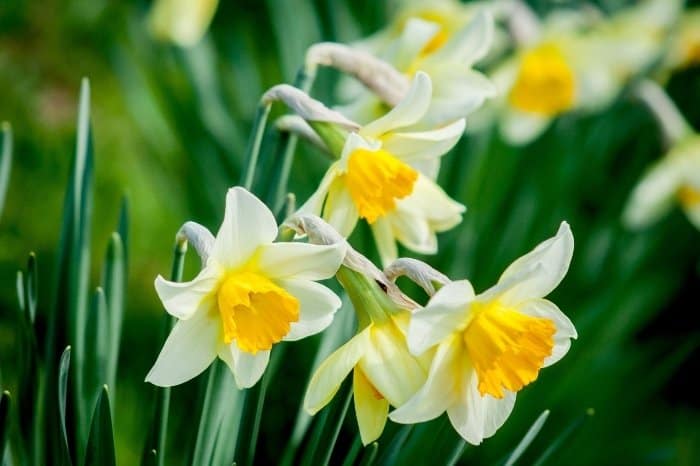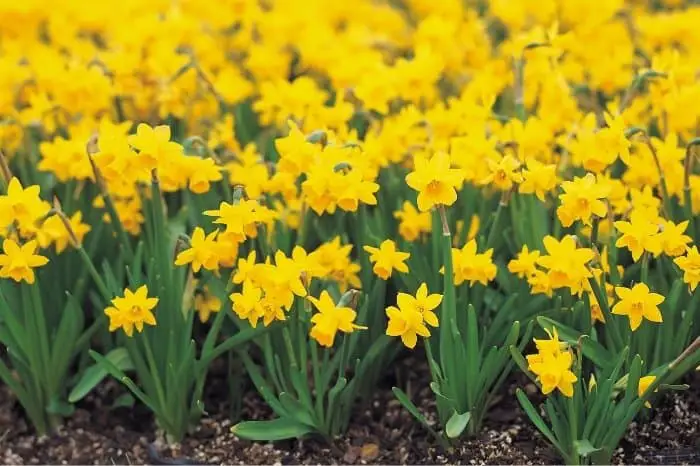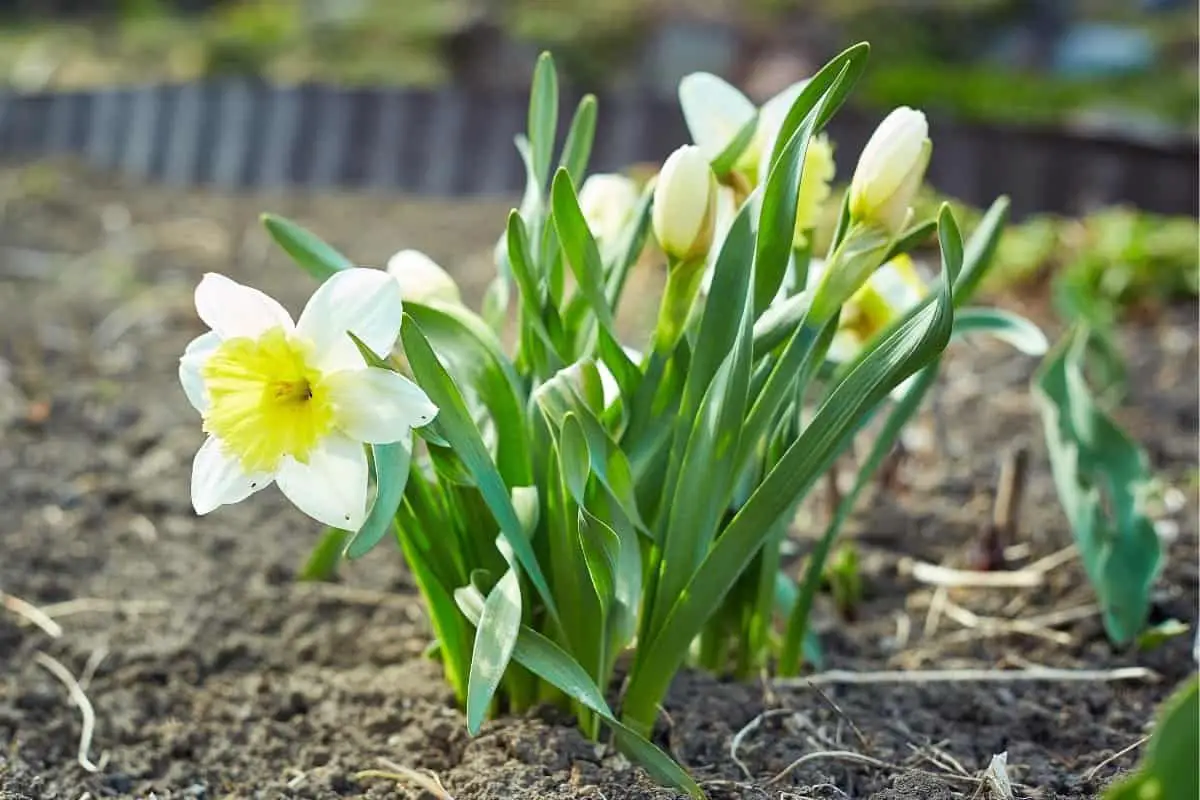Last Updated on December 12, 2021 by Cristina
Most flowers are planted in spring, but when do you plant daffodils if we know they bloom in early spring, right after the snow cover has melted? Daffodils are the first signs of spring, a ray of sunshine that emerges from the recently defrosted ground. Their majestic shape and vibrant color make you want a whole flower bed of daffodils!
Getting on the task, let’s see what’s the best time to plant them. This article might come to you right on time!
Daffodils: The Symbol Of Hope
Daffodils are enchanting white or yellow spring flowers with trumpet-shaped corona, six petals, and lush green foliage. They grow in early spring, and the flowers keep up for three weeks. What’s interesting about daffodils is that they endure and bloom even after a harsh winter. This is the reason why they’re known as the symbol of hope, revival, and forgiveness.

The Legend Behind
You can also find daffodils under their Latin name Narcissus. This is the official name of the flowers in some languages. Narcissus was the son of a Greek god, a beautiful young man. But his beauty came with arrogance. He often visited a lake to stare at his own reflection. He wanted to get so close to his refraction that he fell and drowned one day. So the flowers growing by the river bed were named after him. Some even claim that their nodding blossoms mimic Narcissus’ head over the river.
Types Or Daffodils
There are over 13,000 daffodil varieties, but the commonly cultivated ones are less than 15. The most common kind is the Dutch Master. It features yellow petals and crown, can grow up to 16 inches, and blooms early to mid-spring.
The Crewenna type is light yellow with a darker corona. The trumpet is almost taller than the surrounding petals. They’re more elevated and make great cut flowers. The standard white daffodil is named Toto. The Ice Follies are a combo coming from the Netherlands. They feature white petals and yellow corona.
How To Plant Daffodil Bulbs
Daffodils are spring bulbs that need to be planted in the fall. Some cultivars can bloom in late winter or early spring. Even though they’re not native to North America, they’re easy to grow in most parts. Daffodils thrive in USDA Hardiness zones 3 to 8. They won’t grow or bloom in humid and tropical areas like Florida.
As we mentioned, you need to plant daffodils from bulbs. The bulbs are different from regular roots and seeds. The plant stores enough energy in the bulb to survive the dormant period in winter. Bulbs reproduce by developing clusters under the soil. Daffodils can produce seeds if not deadheaded on time.
Growing daffodils from seeds will take you 5 to 6 years until the first bloom. However, some species are unable to reproduce from seed and will require treatments to enhance germination.
When And Where To Plant Daffodils?
Schedule your planting date around 3 weeks from your first frost in the fall. Pick a site in your garden that’s fully exposed to the sun. A partially sunny spot will work, but a shaded one won’t.
Get well-draining soil; bulbs are prone to rotting when exposed to too much water. However, daffodils are generally very tolerant plants, so any soil type will work.
Use a small quantity of bulb fertilizer and work it into the soil. Choose larger fresh bulbs and plant them 2 to 3 times deeper than their height. For a 3 inches tall bulb, go for at least 6 inches depth. Plant daffodils 3 to 6 inches apart for best results in spring. Cover with mulch and remove pr loosen it only when after the last frost has passed.
Water the planted bulbs right away to boost their root development.
Tips On Planting Daffodil Bulbs
-
-
Avoid dried bulbs; there’s a big chance they won’t bloom. Check them thoroughly for moldy and soft spots. If the bulbs are not performing well, add low nitrogen, high-potassium fertilizer after flowering.
-
Don’t plant the daffodils in spaces where you have standing water. This will kill the bulbs before they grow.
-
Deadhead the daffodils before they form seeds. Don’t remove the foliage until 6 weeks after the flowering has finished. The leaves help the bulb receive and store food for the winter.
-
Daffodils contain oxalic acid. This is their natural protection against pests and rodents. But squirrels and critters may try to dig out the bulbs. Protect them by installing a chicken wire over the flower bed.
-
Dutch Master Daffodils (25 Bulbs) – Yellow Daffodil Narcissus Bulbs
How Many Daffodil Bulbs Should I Plant Together
You can plant over 10 bulbs at once in a single flower bed. However, make sure you space them out at least 4 to 8 inches. When working with smaller bulbs, you can plant up to 3 bulbs in a single hole. Avoid planting daffodils too close to a fence or wall, so there will be no trapped heat around.
Are Daffodils An Annual Plant?
Daffodils are planted from bulbs, and every bulb plant is perennial. They can grow from the same bulb year after year. If you choose a reliable spot in the garden with well-draining soil, you can leave the bulbs in the ground. You should plant the purchased bulbs no later than 12 months. But daffodils don’t have an expiration date; they don’t die after a set number of years. With time they produce fewer flowers.
Caring For Daffodils
Water the daffodils daily, especially in spring when the temperatures rise. Fertilize them a couple of times a year; first when the shoots poke through the ground and then after the first blooms.
Remove the leaves after they wilt and turn yellow. Snip them or twist and pull them gently. After more than 3 years have passed, or you noticed a decrease in flower production, divide the bulbs. In late spring, right before cutting the foliage, dig out and separate the clusters. Then you can replant them.

Bottom Line: When Do You Plant Daffodils
Plant daffodils in the fall a month to 2 weeks before the first frost. Pick high-quality, disease-free bulbs. Choose a bright spot in your garden that receives at least a half-day of sun. A well-draining, neutral to acidic soil is necessary, but some varieties prefer neutral. Don’t forget to water the daffodils daily and fertilize them in late winter and early spring.
Mary is a passionate gardener who loves spending her days getting her hands dirty and nurturing her plants. She‘s an avid reader of gardening magazines and is always looking for new ways to make her garden thrive. When not outside tending to her plants, Mary can be found inside reading up on the latest gardening trends, comparing notes with fellow gardeners, and finding the perfect pottery planter for her next planting project.



